

Doc: textes et interviews. Internet Archaeology. Lempel-Ziv-Welch. Un article de Wikipédia, l'encyclopédie libre.
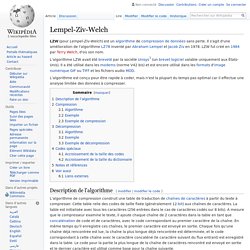
LZW (pour Lempel-Ziv-Welch) est un algorithme de compression de données sans perte. Il s'agit d'une amélioration de l'algorithme LZ78 inventé par Abraham Lempel et Jacob Ziv en 1978. LZW fut créé en 1984 par Terry Welch, d'où son nom. L'algorithme LZW avait été breveté par la société Unisys[1] (un brevet logiciel valable uniquement aux États-Unis). Il a été utilisé dans les modems (norme V42 bis) et est encore utilisé dans les formats d'image numérique GIF ou TIFF et les fichiers audio MOD. L’algorithme est conçu pour être rapide à coder, mais n’est la plupart du temps pas optimal car il effectue une analyse limitée des données à compresser. Design & graphisme par Geoffrey DorneApple : aux origines du graphisme avec Susan Kare ! - Design & graphisme par Geoffrey Dorne.
Don Norman. Donald Arthur Norman (born December 25, 1935) is the director of The Design Lab at University of California, San Diego.[2][3] He is best known for his books on design, especially The Design of Everyday Things.
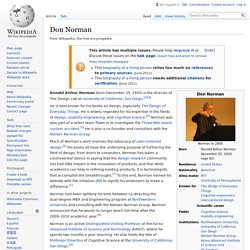
He is widely regarded for his expertise in the fields of design, usability engineering, and cognitive science.[4] Norman was also part of a select team flown in to investigate the Three Mile Island nuclear accident.[5] He is also a co-founder and consultant with the Nielsen Norman Group. Much of Norman's work involves the advocacy of user-centered design.[6] His books all have the underlying purpose of furthering the field of design, from doors to computers.
Norman had been splitting his time between co-directing the dual-degree MBA and Engineering program at Northwestern University and consulting with the Nielsen Norman Group. Jesse James Garrett. Career[edit] Jesse James Garrett is a co-founder of Adaptive Path, a user experience strategy and design firm, and co-founded the Information Architecture Institute.
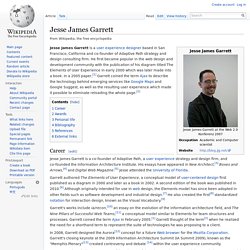
His essays have appeared in New Architect,[3] Boxes and Arrows,[4] and Digital Web Magazine.[5] Jesse attended the University of Florida. Garrett authored The Elements of User Experience, a conceptual model of user-centered design first published as a diagram in 2000 and later as a book in 2002. A second edition of the book was published in 2010.[6] Although originally intended for use in web design, the Elements model has since been adopted in other fields such as software development and industrial design.[7] He also created the first[8] standardized notation for interaction design, known as the Visual Vocabulary.[9] In 2008, Garrett designed the Aurora[12] concept for a future Web browser for the Mozilla Corporation.
Garrett's project "iWitness" was one of the winners of the John S. and James L. Susan Kare. Un article de Wikipédia, l'encyclopédie libre.
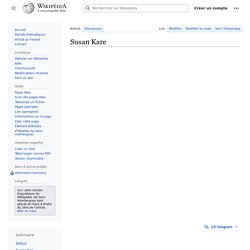
Portrait de Susan Kare Susan Kare (née le 6 avril 1954) est une artiste et graphiste qui a créé de nombreux éléments d'interface et des polices de caractères pour la série d'ordinateurs Apple Macintosh dans les années 1980. Elle fut également directrice artistique (et l'une des premières employées) chez NeXT, l'entreprise que Steve Jobs fonde après avoir quitté Apple en 1985[1]. Elle a travaillé chez Microsoft et IBM et plus récemment pour Pinterest et Facebook. Ward Cunningham. Tim Berners-Lee. Un article de Wikipédia, l'encyclopédie libre.
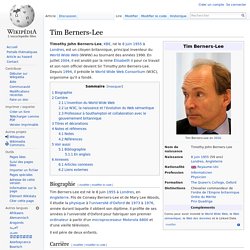
Tim Berners-Lee Tim Berners-Lee en 2010. Compléments Timothy John Berners-Lee, KBE, né le 8 juin 1955 à Londres, est un citoyen britannique, principal inventeur du World Wide Web (WWW) au tournant des années 1990. En juillet 2004, il est anobli par la reine Élisabeth II pour ce travail et son nom officiel devient Sir Timothy John Berners-Lee. John Maeda. John Maeda (born 1966 in Seattle, Washington) is a Japanese-American graphic designer, computer scientist, academic, and author.
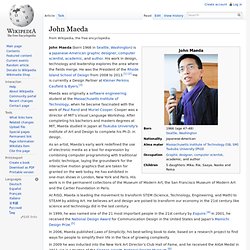
His work in design, technology and leadership explores the area where the fields merge. He was the President of the Rhode Island School of Design from 2008 to 2013.[1] [2] He is currently a Design Partner at Kleiner Perkins Caufield & Byers.[3] Maeda was originally a software engineering student at the Massachusetts Institute of Technology, when he became fascinated with the work of Paul Rand and Muriel Cooper. Cooper was a director of MIT's Visual Language Workshop. Lev Manovich. Lev Manovich is an author of books on new media theory, professor in Computer Science program at City University of New York, Graduate Center, U.S. and visiting professor European Graduate School in Saas-Fee, Switzerland.
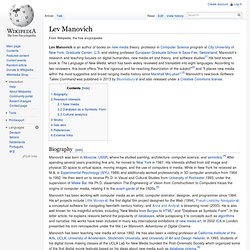
Manovich's research and teaching focuses on digital humanities, new media art and theory, and software studies[1] His best known book is The Language of New Media, which has been widely reviewed and translated into eight languages. According to two reviewers, this book offers "the first rigorous and far-reaching theorization of the subject"[2] and "it places new media within the most suggestive and broad ranging media history since Marshall McLuhan".[3] Manovich's new book Software Takes Command was published in 2013 by Bloomsbury and also released under a Creative Commons license. Biography[edit] Manovich has been working with computer media as an artist, computer animator, designer, and programmer since 1984. Manovich has been teaching new media art since 1992. Alan Turing. Alan Mathison Turing, OBE, FRS (/ˈtjʊərɪŋ/ TEWR-ing; 23 June 1912 – 7 June 1954) was a British mathematician, logician, cryptanalyst, philosopher, pioneering computer scientist, mathematical biologist, and marathon and ultra distance runner.

He was highly influential in the development of computer science, providing a formalisation of the concepts of "algorithm" and "computation" with the Turing machine, which can be considered a model of a general purpose computer.[2][3][4] Turing is widely considered to be the father of theoretical computer science and artificial intelligence.[5] During World War II, Turing worked for the Government Code and Cypher School (GC&CS) at Bletchley Park, Britain's codebreaking centre. For a time he led Hut 8, the section responsible for German naval cryptanalysis. After the war, he worked at the National Physical Laboratory, where he designed the ACE, among the first designs for a stored-program computer.
Ada Lovelace. Augusta Ada King, Countess of Lovelace (10 December 1815 – 27 November 1852), born Augusta Ada Byron and now commonly known as Ada Lovelace, was an English mathematician and writer chiefly known for her work on Charles Babbage's early mechanical general-purpose computer, the Analytical Engine.
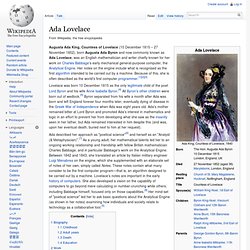
Her notes on the engine include what is recognised as the first algorithm intended to be carried out by a machine. Because of this, she is often described as the world's first computer programmer.[1][2][3] Ada described her approach as "poetical science" and herself as an "Analyst (& Metaphysician)". As a young adult, her mathematical talents led her to an ongoing working relationship and friendship with fellow British mathematician Charles Babbage, and in particular Babbage's work on the Analytical Engine.
Ted Nelson. Biography[edit] Nelson is the son of Emmy Award-winning director Ralph Nelson and the Academy Award-winning actress Celeste Holm.[1] His parents' marriage was brief and he was mostly raised by his grandparents, first in Chicago and later in Greenwich Village.[2] Nelson earned a BA from Swarthmore College in 1959.
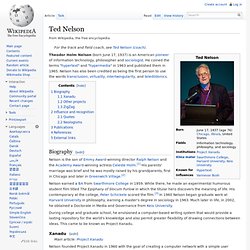
While there, he made an experimental humorous student film titled The Epiphany of Slocum Furlow in which the titular hero discovers the meaning of life. His contemporary at the college, Peter Schickele scored the film.[3] In 1960 Nelson began graduate work at Harvard University in philosophy, earning a master's degree in sociology in 1963. Fing.org - Fondation Internet Nouvelle Génération.
Inria - Inventeurs du monde numérique. World Wide Web Consortium (W3C) Designers interactifs › Le design interactif › Définition. Douglas Engelbart : The Mother of All Demos (1/9)